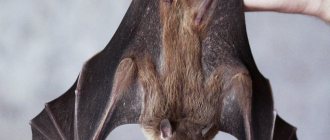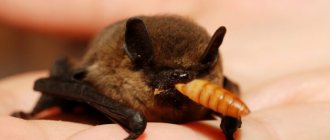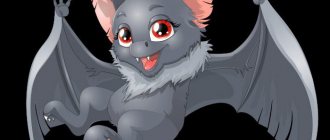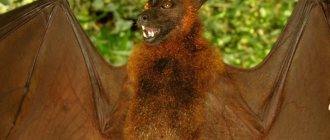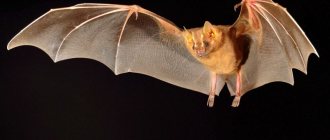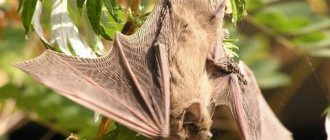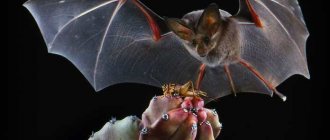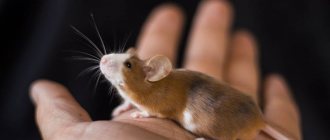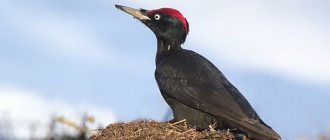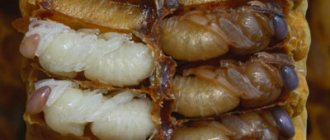Bats are associated with vampires, witches, and sorcerers. Many are sure that these nocturnal animals are capable of sucking blood from a person... What do they actually eat and how dangerous are they for people?
Not only residents of rural areas, but also owners of city apartments can face an invasion of bats. And if in the countryside winged animals take up residence in attics and sheds, then in megacities they nest comfortably on balconies. Why is such a neighborhood dangerous, and how to get rid of uninvited guests who annoy you with squeaks and rustling noises at night?
Bats: description
These animals appeared on our planet several tens of millions of years ago, while scientists found skeletons of bats from the Eocene period. Based on the findings, it was established that these ancient relatives of modern bats did not have significant differences. Although scientists still cannot understand why these living creatures learned to fly.
Appearance
Bats, regardless of their variety, share common features, although there are some differences related to size and other external data. Bats grow hair on their body, which is lighter in color in the abdomen area. The wingspan, depending on the species, can reach almost 2 meters, while the shape of the wings can be different, but the structure is almost identical. The wings of these animals are formed from leathery membranes and muscles, as well as elastic veins. At rest, the animal's wings fit tightly to the body.
Interesting moment! The flight of bats is unthinkable without the synchronized work of the hind limbs.
Bats have well-developed forelimbs, which consist of strong, short shoulders and long forearms, which are formed by a single radius bone. The thumb of the forelimb is armed with a hooked claw, while other rather long fingers serve as support for the wing membranes and are located on the sides.
The length of the tail, as well as the shape of the body, depends on the species. Thanks to the presence of a special bony outgrowth called a “spur,” many species turn their wings toward the tail without any problems.
Behavior and lifestyle
All bats, regardless of species, prefer to be nocturnal. During the day they rest, hanging head down in their shelters, in the form of caves or various wooden buildings.
Bats are capable of falling into a state of suspended animation, which is characterized by a slowdown in the speed of vital processes. As a result of this, the animals' breathing rate slows down and their heart rate slows down. This allows the animals to remain in a state of torpor for a long period of time. As a rule, this is typical for cold seasons. Being in this state, animals can easily do without food.
Interesting fact! Typically, these animals fly at a speed of no more than 15 km/h, but during hunting, bats are able to accelerate to almost 60 km/h.
Regardless of their habitat conditions, bats have a similar lifestyle and habits. Bats do not build nests and live in numerous colonies, although there are species that prefer to live separately. When these animals rest, they take very careful care of their bodies, and especially their wings. While at rest, many species become completely helpless, while some species move perfectly with the help of tenacious paws.
How long do bats live?
Compared to other members of the mammal class, bats have an impressive lifespan. For example, the brown bat is known to live for several decades.
8 FACTS ABOUT BATS
Habitat
Bats inhabit almost every corner on earth.
The exceptions are Antarctica, the Arctic and some parts of the continents, where the temperature does not rise above zero during the year. Another exception is oceanic and sea islands. But the bats simply could not get there. Scientists believe that if animals are taken to the islands, they will calmly take root and reproduce.
The largest populations are recorded in subtropical and tropical forests. Bats like warm climates and plenty of food. The warmer it is, the more insects, ripe fruits and pollen, and therefore food for growing colonies.
Types of bats with photos
There are many species of “chiroptera”, and their differences lie in the different structure of the skeleton and the number of teeth. The main species of bats include:
Tailless or Honduran white bat
It is considered the smallest variety, with a body length of no more than 5 centimeters. The habitat of this animal extends to Honduras, as well as to the countries of Central America. The basis of the diet is fruits. These animals can be found in groups of 5-6 individuals.
Hog-nosed bat (Craseonycteris thonglongyai)
The length of this animal without a tail is about 3 and a half cm, with a weight of about 20 grams. The animal got its name due to the shape of its nose, which resembles a pig's snout. The habitat of such bats extends to Thailand and neighboring countries. Here they settle in limestone caves and feed in thickets of bamboo and teak.
Evening bat (Nyctalus noctula)
On the contrary, it is a larger representative of its genus. Includes 13 subspecies. Individuals grow up to half a meter in size. They fly out in search of food at dusk and before dawn. The animal feeds on butterflies, beetles, and some birds. This variety is found in North America, as well as in some European countries. The main habitats are associated with dense green areas.
Bat dog and fox (fruit mouse)
The variety differs in that it has an elongated muzzle. The animals grow to almost 0.4 meters with a wingspan of almost 0.7 meters and a weight of almost 1 kilogram. Found in the tropics. The basis of the diet is fruits, as well as flower nectar.
Smooth-nosed bat (Vespertilionidae)
This variety includes up to 3 hundred subspecies. The family is distinguished by the fact that it has a smooth muzzle, without the presence of growths in the form of cartilage. About 40 subspecies live in our country. With the onset of winter cold, they fall into a state of suspended animation.
Long Eared Ears (Plecotus)
A characteristic feature of the species is the presence of large locator ears, as well as the shape of the wings. These animals have short but wide wings, and their body length is within 6 centimeters. Long-eared bats feed on various nocturnal insects, in the form of butterflies, mosquitoes, beetles, etc.
Bulldog bat (Molossidae)
This variety is distinguished by the presence of relatively long, but narrow and pointed wings. This allows the animal to make more frequent movements of its wings in flight. They grow no more than 15 centimeters in length. Their habitat is associated with the tropics, where they sometimes form numerous colonies.
Vampire bats may be of particular interest because they are not so harmless animals. These bats pose a danger not only to various animals, but also to people. The bite of this animal may not be harmless, since they are carriers of dangerous and sometimes fatal diseases.
Carnivores
Bats that prefer flesh look very different from their herbivorous comrades. These animals have fairly sharp teeth and large body sizes.
They prefer small animals as food: lizards, frogs, mice (not flying ones) and some small birds. For example, warblers.
Help: Somehow, flying animals manage to determine which frogs can be poisonous and which cannot. There was not a single case where predators made a mistake in their choice.
Despite this diet, carnivorous mice very often feed on insects. They are not averse to eating beetles or butterflies. The method of hunting their prey is the same as that of insectivores.
The difference is that such a prey cannot be eaten in the air, so the bats rush at it, press it with their body and wings, which form a kind of net and then kill the prey.
What do bats eat?
Bats have a relatively high rate of vital processes, which is impossible without an appropriate amount of food. Adults eat so many food items in one night that their weight is 1/3 of the weight of the animal itself. If we take into account the size of the colony, then during the summer period several hundred bats destroy more than half a million different insects, including pests of agriculture and forestry. Especially numerous colonies destroy more than tens of millions of pests during the summer period.
Important point! Since bats have thin but wide wings, they quickly lose moisture. If they do not have free access to water, this sometimes causes the death of these useful animals.
The species that prefer to live in the tropics have a fairly long tongue, which allows the animals to feed on pollen as well as nectar. This, in turn, ensures the spread of most wild plants in the tropics. At the same time, there are also predatory varieties of such animals. A characteristic feature of such species is the presence of large and fairly sharp teeth. Their diet consists of rodents and small birds.
Insectivores
Mice that eat insects don't eat everything.
Each animal has its own taste preferences. Some people love bugs and midges, some love butterflies and moths, while others enjoy eating small spiders or enjoying wood larvae.
Mice can hunt such small prey either in groups or individually.
Mice only catch insects in the air. Thanks to ultrasound, they calculate the location of the insect and capture it.
Some species prefer to immediately swallow the prey in the air, others grab it with their wings, as if it were a net or blades.
Others use their tail membrane. They form a net and catch the insect with it.
But there are very few such bats. Usually hunting and eating occur at the same time, but sometimes mice throw a “dinner party” for a family or even a colony.
Reproduction and offspring
The characteristics of the reproduction process of these mammals depend on the species, as well as natural habitats.
For example:
- Smooth-nosed bats give birth to no more than 4 pups each year.
- Long-eared cats reproduce no more than 2 cubs.
- The “flying fox” reproduces offspring in the amount of 1 cub.
Important point! Only the bulldog bat gives birth about three times annually, with only 1 baby being born at a time.
Most species, as well as subspecies, do not have a high reproduction rate, since the female gives birth to only one calf in one year.
Population and species status
Some species of bats in modern times are classified as rare animals, and some of them are already considered extinct, such as the common bat. Species such as the pointed-eared nightbird and the two-colored cauldron are listed in the Red Book.
It should be noted that recently the trend has changed for the better. Bat populations are increasing, albeit slowly. This is due to the fact that recently they have begun to use chemicals more wisely, including for the purpose of saving.
